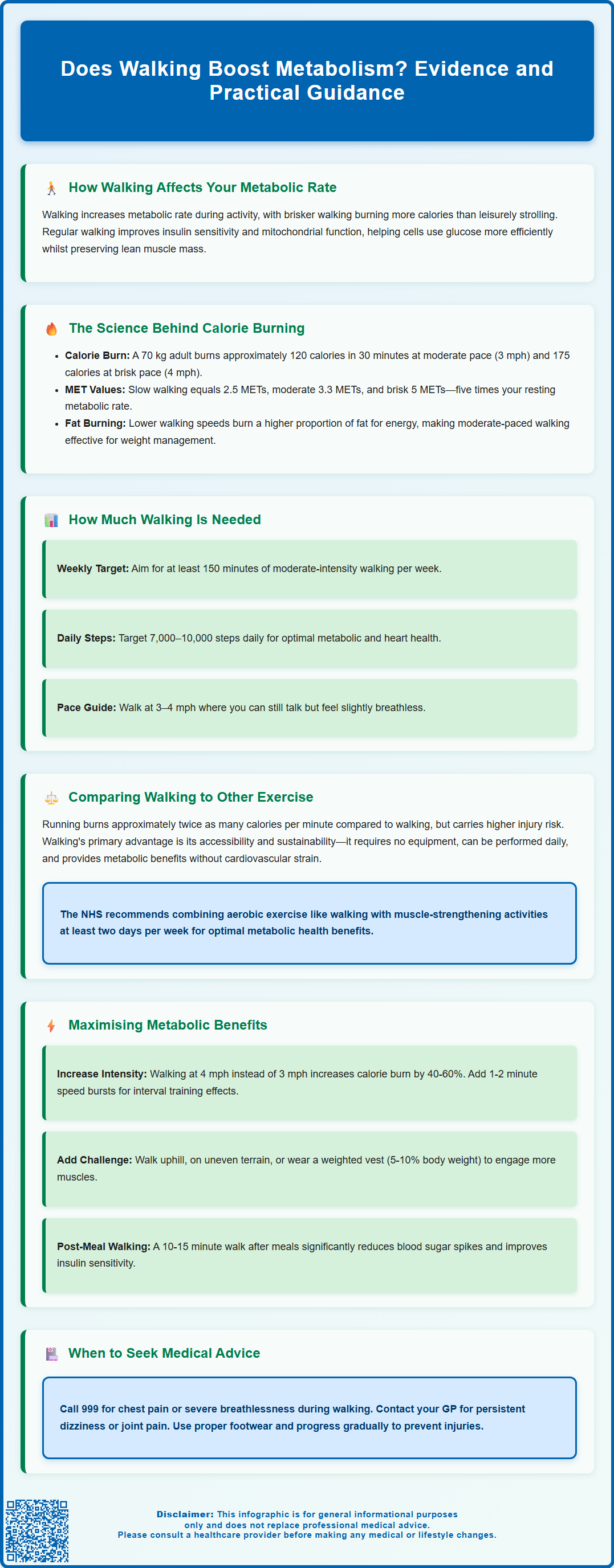Wegovy®
A weekly GLP-1 treatment proven to reduce hunger and support meaningful, long-term fat loss.
- ~16.9% average body weight loss
- Boosts metabolic & cardiovascular health
- Proven, long-established safety profile
- Weekly injection, easy to use

Does walking boost metabolism? This common question reflects growing interest in accessible approaches to metabolic health. Walking does increase metabolic rate during activity and provides sustained benefits through improved insulin sensitivity, preserved muscle mass, and enhanced mitochondrial function. Whilst the immediate caloric expenditure is modest compared to vigorous exercise, walking's accessibility and sustainability make it a valuable metabolic intervention. Regular brisk walking, aligned with UK Chief Medical Officers' guidelines of 150 minutes weekly, contributes meaningfully to overall energy balance and metabolic regulation. This article examines the physiological mechanisms, practical requirements, and evidence-based strategies for maximising walking's metabolic benefits.
Summary: Walking does boost metabolism by increasing energy expenditure during activity and supporting long-term metabolic health through improved insulin sensitivity and preserved muscle mass.
Walking does indeed influence metabolic rate, though the extent and duration of this effect depend on several physiological factors. Metabolism refers to all chemical processes that maintain life, with basal metabolic rate (BMR) representing the energy expended at complete rest. Physical activity, including walking, increases energy expenditure above this baseline through a combination of immediate fuel consumption and post-exercise metabolic elevation.
During walking, your body increases oxygen consumption and heart rate to meet the energy demands of muscle contraction. This acute metabolic response is proportional to walking intensity—brisker walking requires more energy than leisurely strolling. The primary fuel sources shift between carbohydrates and fats depending on pace and duration, with moderate-intensity walking generally favouring fat oxidation. Importantly, regular walking can contribute to excess post-exercise oxygen consumption (EPOC), a phenomenon where metabolic rate remains slightly elevated after activity ceases, though this effect is modest and short-lived compared to higher-intensity exercise.
Beyond immediate calorie burning, consistent walking supports metabolic health through several mechanisms. It helps preserve lean muscle mass, which is metabolically active tissue that contributes to resting energy expenditure. Meaningful muscle gain typically requires resistance training. Walking also improves insulin sensitivity, allowing cells to utilise glucose more efficiently, and supports mitochondrial function—the cellular powerhouses responsible for energy production. For individuals with sedentary lifestyles, incorporating regular walking represents a significant metabolic stimulus.
Whilst walking alone produces moderate metabolic increases, its accessibility and sustainability make it a valuable component of metabolic health strategies. The cumulative effect of daily walking, combined with its cardiovascular and musculoskeletal benefits, contributes meaningfully to overall energy balance and metabolic function over time, as recognised in the UK Chief Medical Officers' Physical Activity Guidelines.

The caloric expenditure during walking is determined by multiple variables, including body weight, walking speed, terrain, and individual metabolic efficiency. For an average 70 kg adult, moderate-paced walking (around 3 mph or 4.8 km/h) represents approximately 3.3 METs (metabolic equivalents), burning roughly 4 calories per minute or about 120 calories during a 30-minute walk. Brisk walking at 4 mph (6.4 km/h) increases to approximately 5 METs, burning around 175 calories in 30 minutes for the same person.
The metabolic equivalent of task (MET) system provides a standardised measure of energy expenditure. Slow walking (2 mph or 3.2 km/h) registers approximately 2.5 METs, whilst brisk walking (4 mph or 6.4 km/h) reaches 5 METs—representing five times the resting metabolic rate. Walking uphill or on uneven surfaces substantially increases energy demands, with the increase proportional to the gradient. These values help healthcare professionals prescribe appropriate activity levels and allow individuals to estimate their energy expenditure.
Substrate utilisation during walking varies with intensity. At lower intensities, fat oxidation tends to be proportionally higher, with the body deriving more energy from fat stores. As pace increases, carbohydrate contribution rises, though moderate walking maintains a favourable balance for fat utilisation. This makes walking particularly valuable for individuals managing weight or metabolic conditions like type 2 diabetes.
The thermic effect of activity extends beyond the walk itself. Studies demonstrate that metabolic rate can remain modestly elevated for a short period post-exercise, depending on duration and intensity. Whilst this EPOC effect is less pronounced than with vigorous exercise, regular walking creates cumulative metabolic benefits. Additionally, walking stimulates various physiological responses that support metabolic regulation throughout the day, contributing to its overall health benefits as highlighted by NHS guidance.
Current UK guidelines from the Chief Medical Officers advise adults to accumulate at least 150 minutes of moderate-intensity activity weekly, which can be effectively achieved through walking. This can be spread throughout the week in sessions of any duration—even short walks count towards your weekly total. For metabolic benefits, consistency matters more than single prolonged sessions—regular daily walking provides sustained metabolic stimulation.
To meaningfully boost metabolism, walking should reach moderate intensity, characterised by increased heart rate and breathing whilst still being able to hold a conversation. This typically corresponds to 3–4 miles per hour (4.8–6.4 km/h) for most adults. Using a simple self-assessment, you should feel somewhat breathless but not exhausted. Incorporating brisk intervals—alternating between comfortable and faster paces—can enhance metabolic response without requiring sustained high intensity, making it accessible for various fitness levels.
Step count targets offer practical guidance, with 7,000–10,000 steps daily associated with metabolic and cardiovascular benefits in research studies. However, even modest increases from baseline activity levels produce measurable improvements. For sedentary individuals, beginning with 3,000–5,000 steps and gradually increasing by 500–1,000 steps weekly represents a sustainable approach. The metabolic advantages accumulate progressively—each additional 1,000 steps per day contributes to improved glucose regulation and energy expenditure.
For those seeking greater metabolic impact, increasing either duration or intensity amplifies benefits. Walking for 45–60 minutes daily, or incorporating hills and varied terrain, substantially increases caloric expenditure. However, it's essential to progress gradually to avoid musculoskeletal injury. Individuals with unstable cardiovascular disease, uncontrolled symptoms, or concerning signs during exercise should seek medical advice before significantly increasing activity levels to ensure appropriate intensity and monitoring. Most adults can safely increase their walking without routine GP consultation.
When evaluating metabolic impact, walking occupies a moderate position on the exercise intensity spectrum. Running burns approximately twice as many calories per minute (8–12 calories) compared to walking, with greater EPOC effects lasting several hours post-exercise. High-intensity interval training (HIIT) produces more pronounced metabolic elevation, with studies showing increased fat oxidation that can persist for several hours afterwards, though the duration and magnitude vary depending on the specific protocol. However, these higher-intensity activities carry increased injury risk and may be unsuitable for individuals with joint problems, obesity, or cardiovascular conditions.
Cycling at moderate intensity produces similar caloric expenditure to brisk walking (4–6 calories per minute) but with reduced impact on joints, making it advantageous for those with arthritis or mobility limitations. Swimming offers comparable metabolic benefits whilst providing whole-body resistance, though accessibility to facilities may limit regular participation. Resistance training, whilst burning fewer calories during the activity itself, builds muscle mass that elevates resting metabolic rate—an effect not achieved through walking alone.
The key advantage of walking lies in its accessibility, sustainability, and safety profile. Unlike vigorous exercise, walking can generally be performed daily with appropriate progression, allowing for consistent metabolic stimulation. It requires no equipment, specialist facilities, or particular fitness level, removing common barriers to physical activity. For older adults, individuals with chronic conditions, or those new to exercise, walking provides metabolic benefits without the cardiovascular strain or injury risk associated with more intense activities.
Optimal metabolic health likely benefits from combining walking with other exercise modalities. The NHS recommends incorporating muscle-strengthening activities on at least two days weekly alongside aerobic exercise. A balanced approach might include daily walking for cardiovascular and metabolic benefits, supplemented with resistance exercises to build metabolically active muscle tissue. This combination addresses multiple aspects of metabolic health whilst remaining achievable for most individuals.
Several evidence-based strategies can enhance the metabolic impact of walking without requiring excessive time commitment. Increasing pace represents a straightforward approach—walking at 4 mph (6.4 km/h) rather than 3 mph (4.8 km/h) increases energy expenditure by approximately 40-60%. Incorporating short bursts of faster walking (1–2 minutes) followed by recovery periods creates an interval effect that elevates metabolism more than steady-state walking. This approach, sometimes called "fartlek" walking, provides metabolic benefits approaching those of jogging whilst remaining lower impact.
Terrain variation increases energy demands. Walking uphill engages larger muscle groups and increases caloric burn, with the effect proportional to the gradient—steeper hills require more energy. If hills aren't accessible, using stairs or adjusting treadmill incline achieves similar effects. Uneven surfaces like trails or beaches require additional stabilisation effort, modestly increasing energy expenditure. Adding a weighted vest (5–10% of body weight) can enhance intensity, though this should be introduced gradually to avoid joint stress.
Timing considerations may influence metabolic outcomes, though evidence remains mixed. Some research suggests walking before breakfast may enhance fat utilisation, whilst post-meal walking (particularly after dinner) improves glucose metabolism and insulin sensitivity. For people with type 2 diabetes or those at high risk of developing it (non-diabetic hyperglycaemia), a 10–15 minute walk after meals can significantly reduce blood glucose spikes. However, the most important factor remains consistency—walking at whatever time fits your schedule is preferable to not walking at all.
To sustain long-term metabolic benefits, progressive overload is essential. Gradually increasing duration, frequency, or intensity prevents metabolic adaptation where the body becomes more efficient and burns fewer calories for the same activity. Tracking steps, distance, or duration helps monitor progress and maintain motivation. Combining walking with a balanced diet that includes adequate protein and some resistance training supports healthy body composition, as muscle preservation is crucial for maintaining metabolic rate during weight management.
Safety considerations should guide progression. If you experience chest pain suggestive of a heart attack or severe, unexplained breathlessness, call 999 immediately. Contact your GP if you experience persistent dizziness, joint pain, or concerning symptoms during walking. People living with obesity or long-term conditions may benefit from NHS exercise referral schemes initially. Proper footwear, hydration, and gradual progression help prevent common walking-related injuries such as plantar fasciitis or shin splints, ensuring that walking remains a sustainable metabolic intervention.
Walking burns approximately 4 calories per minute at moderate pace, whilst running burns 8–12 calories per minute—roughly twice as many. However, walking's lower impact and sustainability allow for more frequent activity, contributing to cumulative metabolic benefits.
UK guidelines recommend at least 150 minutes of moderate-intensity walking weekly, which equates to approximately 20–30 minutes daily. Even shorter walks contribute to metabolic benefits, with consistency being more important than single prolonged sessions.
Yes, walking speed significantly affects metabolic impact. Brisk walking at 4 mph increases energy expenditure by 40–60% compared to leisurely walking at 3 mph, whilst also enhancing cardiovascular benefits and post-exercise metabolic elevation.
The health-related content published on this site is based on credible scientific sources and is periodically reviewed to ensure accuracy and relevance. Although we aim to reflect the most current medical knowledge, the material is meant for general education and awareness only.
The information on this site is not a substitute for professional medical advice. For any health concerns, please speak with a qualified medical professional. By using this information, you acknowledge responsibility for any decisions made and understand we are not liable for any consequences that may result.
Lorem ipsum dolor sit amet, consectetur adipiscing elit, sed do eiusmod tempor incididunt ut labore et dolore magna aliqua. Ut enim ad minim veniam, quis nostrud exercitation ullamco laboris nisi ut aliquip ex ea commodo consequat. Duis aute irure dolor in reprehenderit in voluptate velit esse cillum dolore eu fugiat nulla pariatur.
Block quote
Ordered list
Unordered list
Bold text
Emphasis
Superscript
Subscript